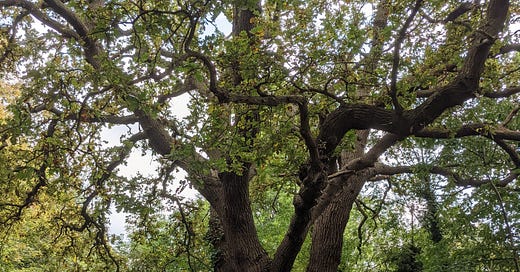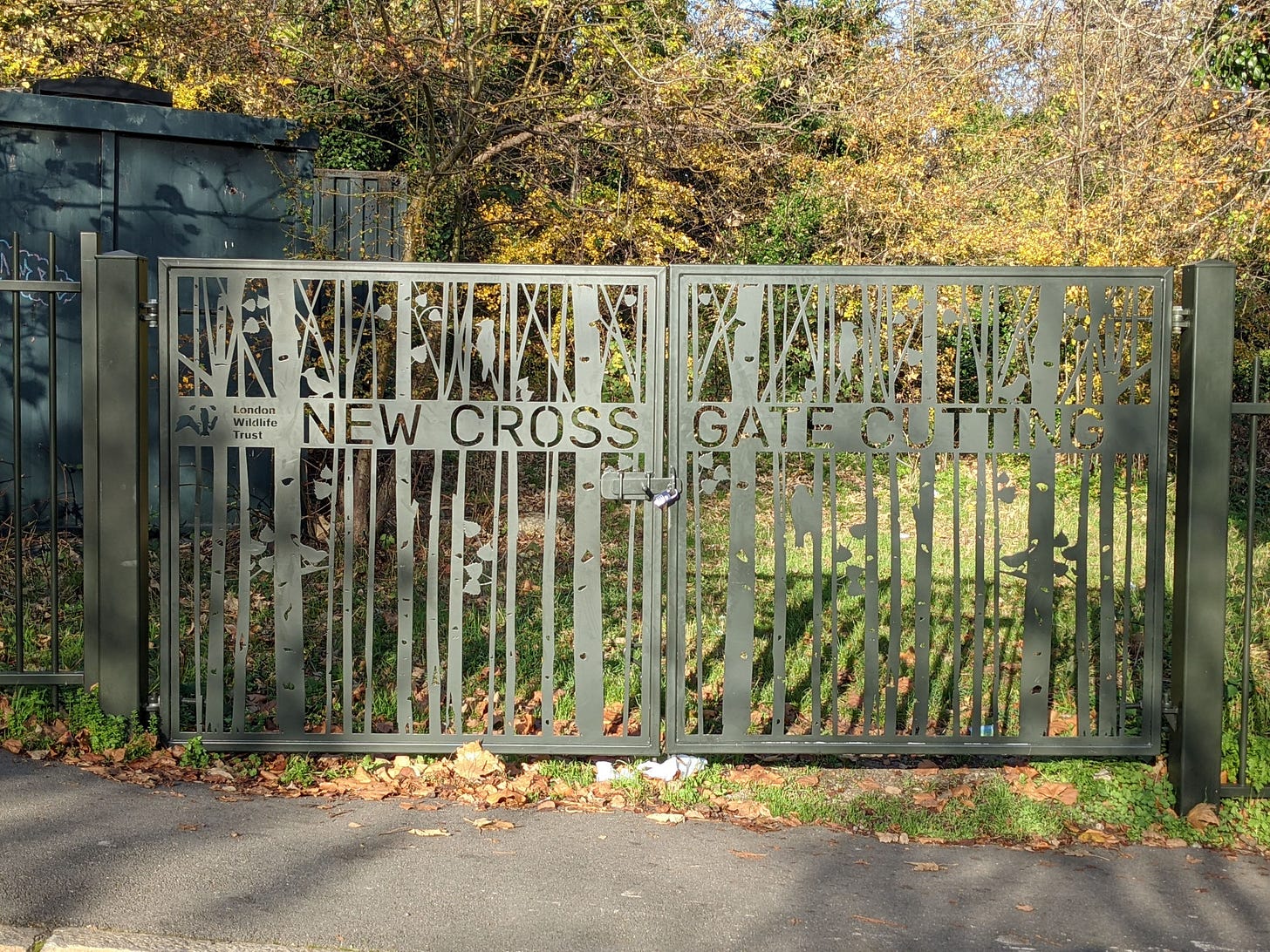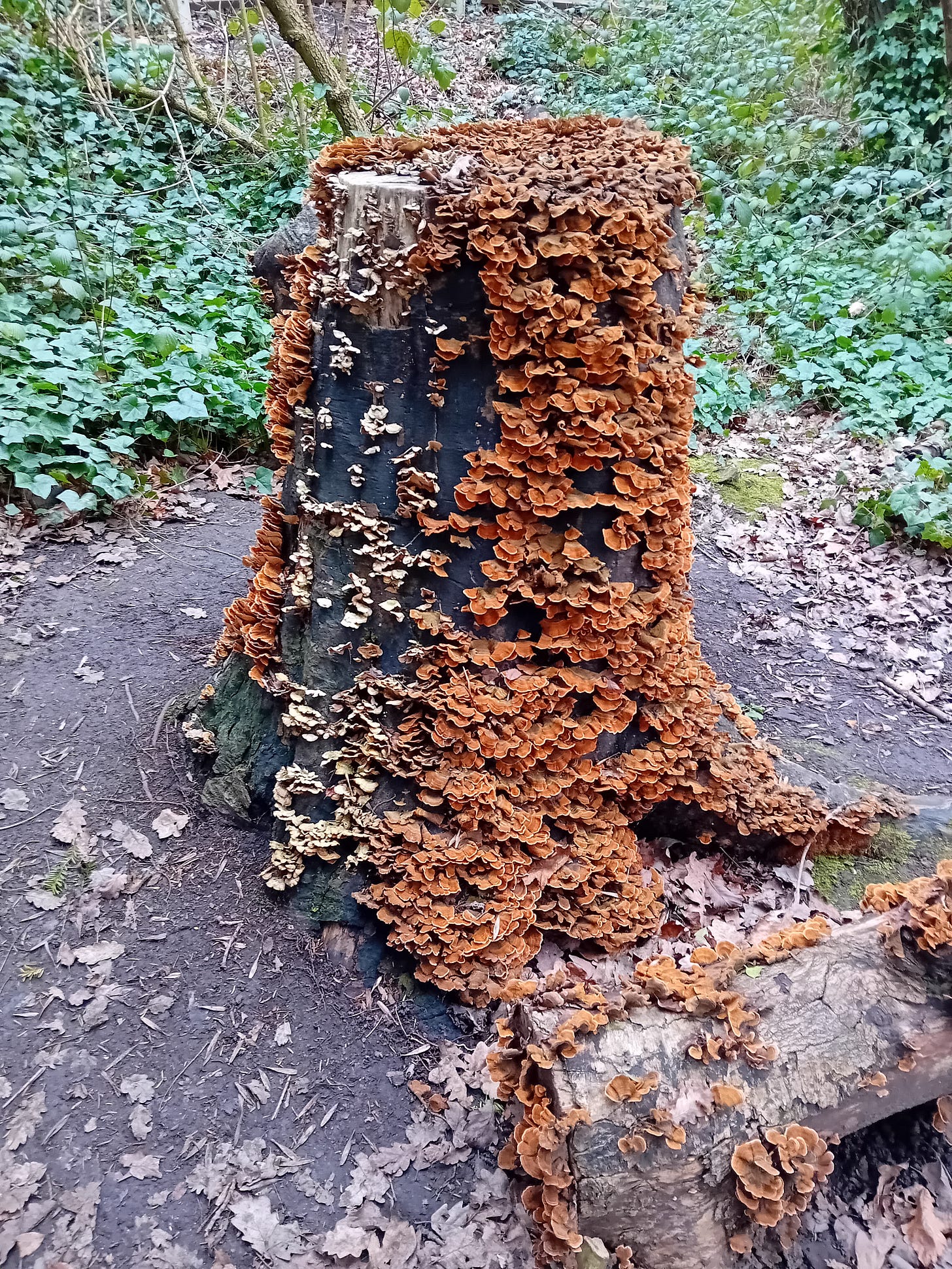There’s a hilltop park a few minutes’ walk from my house. Hilly Fields is a place that I’ve visited many times since I lived in the area and one of the things that has always drawn me here is the view from the top of the park. Look to the North and the skyline is dominated by the tall buildings at Canary Wharf only a couple of miles away. Look South and there are other distinctive towers – the television transmitters at Crystal Palace and its smaller neighbour at Beulah Hill. But there is evidence of a much older, wilder landscape here too.
The TV transmitters sit on a ridge of a high ground which at first glance appears to be almost completely wooded. There are houses and other buildings among the trees, but that first impression is not entirely wrong for whole stretches of the ridge are covered in woods. These are fragments of a vast area of woodland which once stretched across a large part of south-east London, and which for much of its existence was known simply as the North Wood, probably to distinguish it from the other huge woods of Croydon to the South. It was the Victorians who made it great and gave it the name we know it by today - the Great North Wood.
The memory of this huge woodland lives on in the name of nearly every station on the train line which loops through this area - Brockley (my local station, named for the badgers who used to live in the woods); Honor Oak Park; Forest Hill; Penge (derived from a word meaning “edge of wood”); West Norwood; and Gipsy Hill (the woods were once home to many gypsies). Tiny patches of the wood itself are still here too, clinging to the sides of railway lines and roads, squeezed onto the edges of housing estates and school grounds, and hidden in plain sight in parks and cemeteries. Between 2017 and 2023 I spent many happy days helping to care for some of these places as part of a London Wildlife Trust (LWT) project to restore the surviving fragments of woodland and make the Great North Wood an important part of local people’s lives once again.
It was a wonderful experience to be part of this initiative. I discovered places near where I live that I never even knew existed and learnt a lot about the history of the woods and the significant role they played in shaping the city we know today. At a time when London was no more than a collection of wooden buildings by the side of the Thames, most of the people in this area would have made their living from the woods or at least relied on them for their survival. The woods supported shipbuilding and many of the other industries which led to the development of the capital. The bark of oak trees was used in leather tanneries – England’s second most important industry in the eighteenth century - pigs foraged for acorns every autumn and both oaks and hornbeams were coppiced to make charcoal.
Involvement in the project also taught me a lot about the species that depend on these woods and those that thrive there and which may not be so welcome. One of the big tasks, particularly in the early days of the project, was clearing cherry laurel from long-neglected areas of woodland. Cherry laurel was first brought to the UK in the sixteenth century, but it is primarily the Victorians who are responsible for its presence in London’s woodland. They particularly prized this vigorous, quick-growing shrub for its shiny, evergreen foliage but it has long since escaped the gardens and hedges where they planted it. If left unmanaged, cherry laurel runs rampant, casting a shadow all year round, and often preventing the growth of other woodland plants. To make matters worse, the seeds and leaves contain cyanide which causes the leaves to give off a smell of almonds when crushed. In the eighteenth century, enterprising cooks took advantage of this attribute to flavour baking and drinks. Laurel water was only banned after several people died due to accidental over-consumption and it is also believed to have been used as a murder weapon. It seems cherry laurel truly is a “villain”, as the naturalist, Oliver Rackham, termed this invasive non-native species. I don’t feel any regret that I have contributed to the destruction of so many. It’s really disappointing to see that cherry laurel is still being promoted to gardeners despite some landscaping experts now warning against planting it.
There was more cherry laurel to cut back when I returned to the Great North Wood last Saturday, although thankfully far less than the used to be. This time I was in Dulwich Woods where LWT is now working on a new project to reunite the woods with neighbouring Sydenham Hill Woods. These two ancient woodlands form the largest remaining section of the Great North Wood, and both are much used by local people. There was a steady stream of visitors passing as we worked to repair some of the dead hedges in Dulwich Wood. These have been created in an attempt to keep people from trampling the understorey in certain places and give the woods more chance to regenerate naturally. Dozens of tiny shoots were already emerging through the leaf litter in one area protected by dead hedges. I just hope visitors respect the barriers and give these shoots more chance to grow into mature trees. Restricting access isn’t always popular with visitors but sometimes even those who love the woods need a little help to do what’s best for their future.
To finish….
…a few things I’d like to share:
The Wood that Built London: A Human History of the Great North Wood by C.J. Schuler. This is a fascinating account of the changing fortunes of the Great North Wood from the time trees first established here after the last Ice Age right up until modern times finishing with a chapter considering the value of these places both now and in the future. As well as covering the important contribution the woodland made to London’s development and the impact that humans have had on the woods, Schuler describes how parts of the wood are now protected and looked after as nature reserves and includes some of his own experiences as conservation volunteer at Sydenham Hill Woods.
Gossip from the Forest: The Tangled Roots of Our Forests and Fairy Tales by Sara Maitland. Each chapter of this book describes a visit to a different area of woodland which Maitland associates with a particular fairy tale. One chapter covers a visit to Sydenham Hill Woods and Dulwich Woods in which Maitland briefly discusses the Great North Wood’s long association with gypsies and the links between gypsies and fairy tales. The fairy tale chosen for this chapter is ‘The Little Goosegirl’, a story in which secrecy plays an important role and Maitland links that to the strong sense of secrecy she experiences in the small pockets of surviving woodland. For her the Great North Wood is still here, but secret and baffling, hiding and disguising itself like the protagonists of the fairy stories.
Nearby Nature: A creative writing workshop. Next Saturday (17 February), I’m running a writing workshop as part of a day of nature-related talks and events organised by Growing Greenwich Community Network. The workshop will be a relaxed and informal opportunity to discuss some pieces of urban nature writing and have a go at doing some writing of your own. You can book a place here.







This is a wonderful post with so many threads I’d love to pull on. I’ve also enjoyed Sara Maitland’s book, and am fascinated by the role that gypsies have played in our woodlands.
Really glad you enjoyed it. I'll definitely be writing more about different parts of the Great North Wood in future posts.